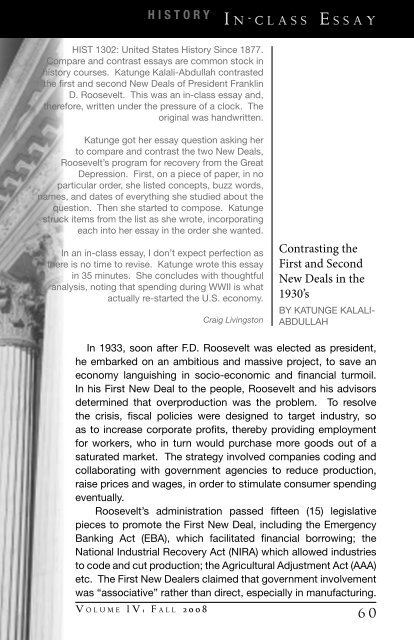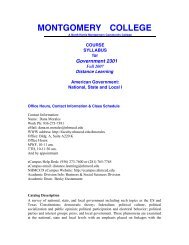2008 - Communication Across the Curriculum (CAC)
2008 - Communication Across the Curriculum (CAC)
2008 - Communication Across the Curriculum (CAC)
You also want an ePaper? Increase the reach of your titles
YUMPU automatically turns print PDFs into web optimized ePapers that Google loves.
H i s t o r y<br />
I n - c l a s s E s s a y<br />
HIST 1302: United States History Since 1877.<br />
Compare and contrast essays are common stock in<br />
history courses. Katunge Kalali-Abdullah contrasted<br />
<strong>the</strong> first and second New Deals of President Franklin<br />
D. Roosevelt. This was an in-class essay and,<br />
<strong>the</strong>refore, written under <strong>the</strong> pressure of a clock. The<br />
original was handwritten.<br />
Katunge got her essay question asking her<br />
to compare and contrast <strong>the</strong> two New Deals,<br />
Roosevelt’s program for recovery from <strong>the</strong> Great<br />
Depression. First, on a piece of paper, in no<br />
particular order, she listed concepts, buzz words,<br />
names, and dates of everything she studied about <strong>the</strong><br />
question. Then she started to compose. Katunge<br />
struck items from <strong>the</strong> list as she wrote, incorporating<br />
each into her essay in <strong>the</strong> order she wanted.<br />
In an in-class essay, I don’t expect perfection as<br />
<strong>the</strong>re is no time to revise. Katunge wrote this essay<br />
in 35 minutes. She concludes with thoughtful<br />
analysis, noting that spending during WWII is what<br />
actually re-started <strong>the</strong> U.S. economy.<br />
Craig Livingston<br />
Contrasting <strong>the</strong><br />
First and Second<br />
New Deals in <strong>the</strong><br />
1930’s<br />
by Katunge Kalali-<br />
Abdullah<br />
In 1933, soon after F.D. Roosevelt was elected as president,<br />
he embarked on an ambitious and massive project, to save an<br />
economy languishing in socio-economic and financial turmoil.<br />
In his First New Deal to <strong>the</strong> people, Roosevelt and his advisors<br />
determined that overproduction was <strong>the</strong> problem. To resolve<br />
<strong>the</strong> crisis, fiscal policies were designed to target industry, so<br />
as to increase corporate profits, <strong>the</strong>reby providing employment<br />
for workers, who in turn would purchase more goods out of a<br />
saturated market. The strategy involved companies coding and<br />
collaborating with government agencies to reduce production,<br />
raise prices and wages, in order to stimulate consumer spending<br />
eventually.<br />
Roosevelt’s administration passed fifteen (15) legislative<br />
pieces to promote <strong>the</strong> First New Deal, including <strong>the</strong> Emergency<br />
Banking Act (EBA), which facilitated financial borrowing; <strong>the</strong><br />
National Industrial Recovery Act (NIRA) which allowed industries<br />
to code and cut production; <strong>the</strong> Agricultural Adjustment Act (AAA)<br />
etc. The First New Dealers claimed that government involvement<br />
was “associative” ra<strong>the</strong>r than direct, especially in manufacturing.<br />
V o l u m e I V : F a l l 2 0 0 8<br />
6 0






